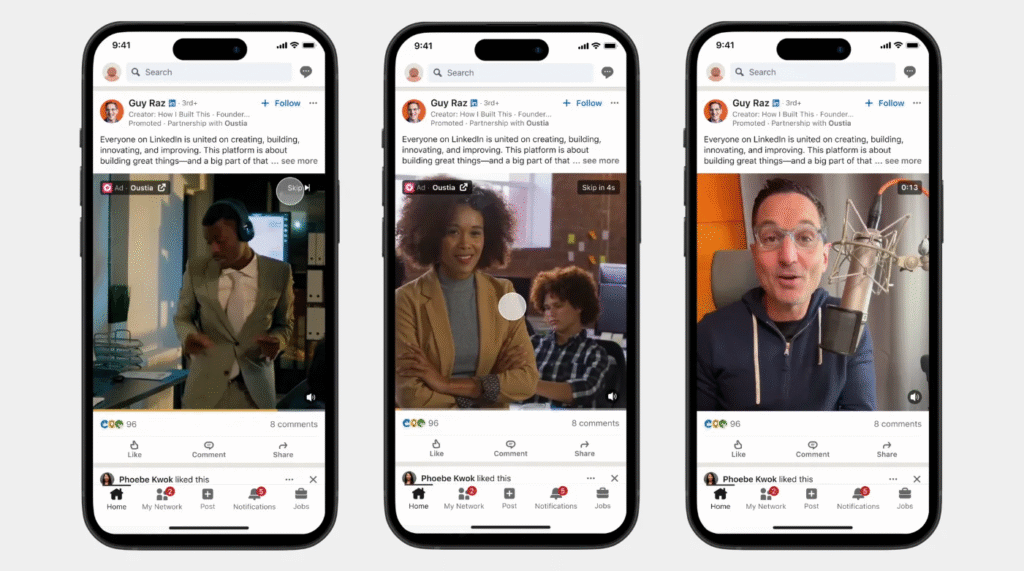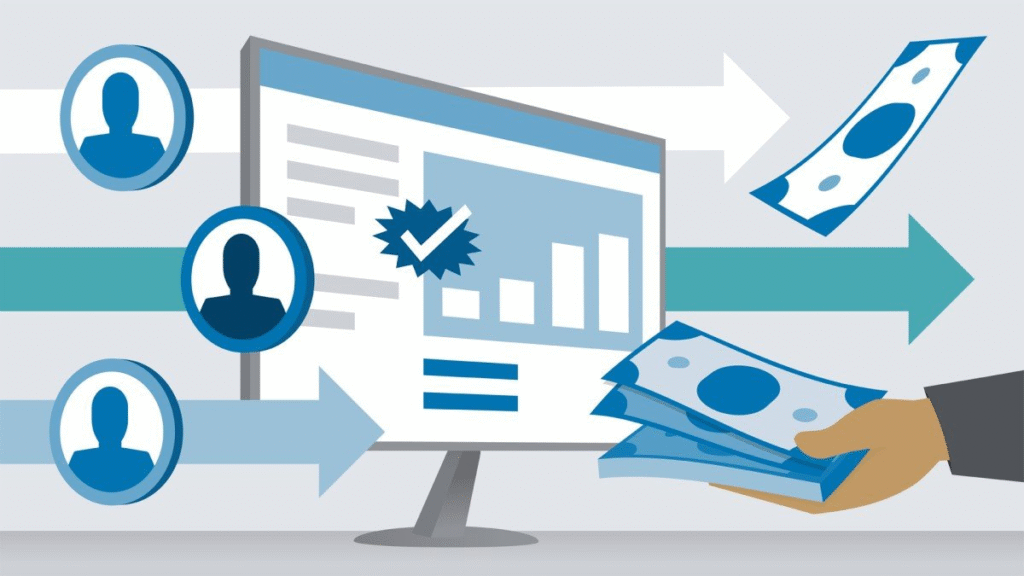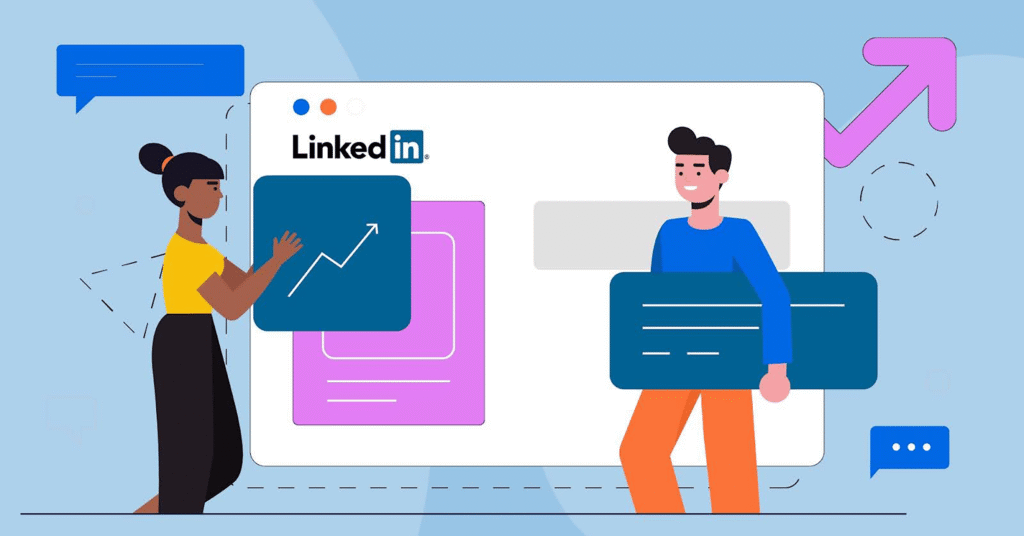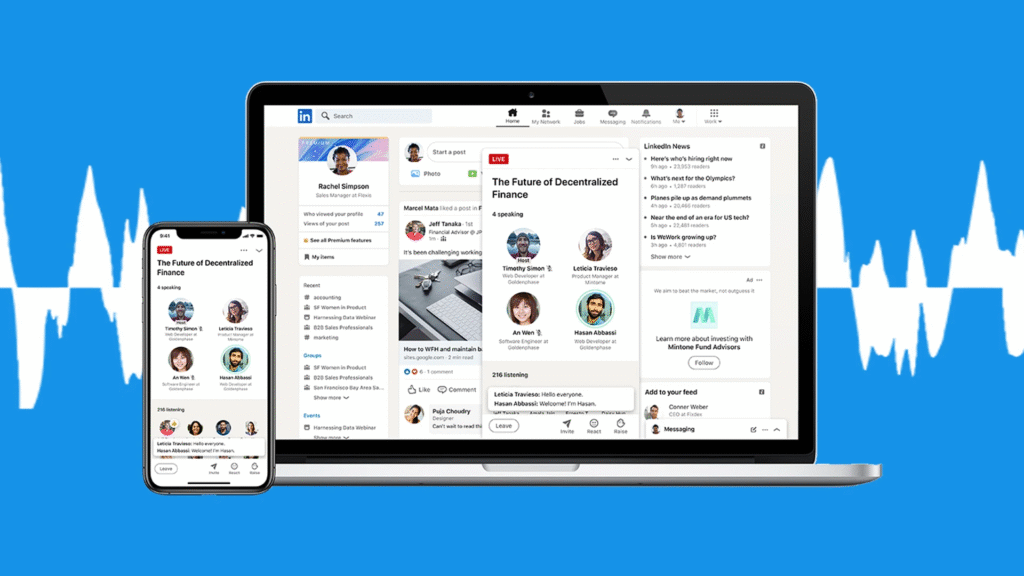Have you ever wondered how people actually make money on LinkedIn—without even leaving the platform? If you’re a creator, coach, freelancer, or marketer looking to turn your content into income, LinkedIn in 2025 offers real potential—some creators are earning upwards of $7,000/month just from brand deals and services alone.
In this guide, you’ll learn exactly how to make money on LinkedIn, even if you’re starting from zero. We’ll explore strategies, step-by-step guides, earnings potential, and tools to help you scale quickly.
Whether you’re hoping to sell a service, promote affiliate products, or grow a paid newsletter, this blog will show you how to do it—the right way, and without getting penalized by LinkedIn’s algorithm.
Key Takeaways
- Multiple ways to earn from LinkedIn: From offering freelance services to launching affiliate campaigns or selling digital products, there are at least 12 proven monetization strategies.
- You don’t need 10,000 followers: Many successful LinkedIn earners have under 5,000 followers—they just know how to engage and sell smartly.
- Avoid algorithm traps: Too many external links or spammy content can kill your reach. This guide shows how to monetize without triggering penalties.
- Tools can speed things up: Automation platforms like Taplio or AuthoredUp can help you scale faster—without violating LinkedIn’s policies.
- It all starts with content and a niche: You’ll learn how to position yourself correctly and build trust to convert views into actual income.
How to Make Money on LinkedIn?
Making money on LinkedIn in 2025 is easier than ever—if you know what you’re doing. Unlike saturated platforms like Instagram or TikTok, LinkedIn still offers organic reach with fewer gatekeepers. Even without a huge following, well-positioned creators are landing high-ticket clients and brand deals thanks to trust-based networking.
However, success depends on providing real value and staying consistent. Spammy tactics, mass-DMs, or link-heavy posts can actually hurt your chances of monetizing. Instead, you’ll need to focus on relationship-driven content, clear positioning, and the right monetization model for your niche.
Another bonus: LinkedIn users are in a “business mindset.” This makes them far more likely to invest in services, courses, or coaching programs than followers on more entertainment-driven platforms.
That said, monetization requires upfront effort. You’ll need a strategic content plan, strong profile, and smart tools. But once it clicks, LinkedIn becomes one of the highest-ROI platforms for personal brands.
What do you need to get started?
To start earning on LinkedIn, you need a professional-looking profile, a clear niche, and a basic content plan. You don’t need thousands of followers, but consistency is key. Tools like Taplio or AuthoredUp can help schedule posts and analyze performance. At minimum, you’ll need:
- A complete LinkedIn profile (with banner, headline, and featured section)
- At least 2–3 content pieces per week
- A clear offer or monetization goal (services, products, or affiliate links)
- Optional tools: Taplio, Shield Analytics, AuthoredUp
How much money can you make on LinkedIn?
LinkedIn income can range from a few hundred dollars a month to over $10,000/month, depending on your audience size, niche, and monetization model. For example, Samantha North earned $3,400 in a single month by selling a digital course and freelancing services through her posts and DMs alone.
Freelancers often charge $500–$2,000 per client, coaches earn $2,000+ per program, and affiliates can earn passive commissions with the right strategy. Even newsletters are becoming a revenue stream with ads and service upsells.
The key? Choosing the right method for your niche—and staying consistent.
17 Best Ways to Make Money on LinkedIn
Whether you’re a creator growing influence or a business owner chasing qualified leads, these 17 proven tactics show exactly how to Make Money on LinkedIn—turning posts, profiles, and relationships into reliable revenue, step by step.
1. Sell Freelance or Consulting Services
One of the fastest ways to make money on LinkedIn is by offering freelance or consulting services. Whether you’re a writer, graphic designer, business coach, or strategist, LinkedIn is full of decision-makers looking for expert help.
You don’t need to be an influencer. A small, engaged audience who trusts your content is enough to land consistent clients. Many professionals earn $1,000–$5,000/month just by building relationships through posts and private messages.
LinkedIn is especially effective for B2B services, coaching, or anything high-ticket. With the right positioning, even a few solid leads can turn into real income quickly.
How to sell freelance or consulting services on LinkedIn?
- Optimize your profile to reflect your service and niche clearly.
- Publish weekly content sharing insights, case studies, or tips in your field.
- Use the “Featured” section to showcase your offer or link to a booking page.
- DM people who engage with your posts, ask thoughtful questions, and offer value.
- Join niche-specific LinkedIn Groups and contribute with valuable input.
- Use search filters to find target clients, then connect and warm up with useful content.
- Use tools like Taplio to schedule and track content engagement.
- Ask satisfied clients for testimonials and feature them on your profile.
Quick tip: Add a free audit or mini-session to increase inbound leads and build early trust.
2. Sell Digital Products

Selling digital products is another scalable way to monetize LinkedIn. These can include e-books, Notion templates, Canva designs, video mini-courses, or guides. If your audience is interested in learning, improving, or saving time, this strategy can work well.
Platforms like Gumroad, Podia, and Stan Store make it easy to sell directly, while tools like AuthoredUp help you format engaging content that drives traffic to your product. Creators like Samantha North have proven that even with a modest following, selling a $49 product to a small audience can generate $1,000+ per month.
How to sell digital products on LinkedIn?
- Define a specific pain point your product solves (e.g., “freelancer onboarding checklist”).
- Build anticipation with teaser posts and launch countdowns.
- Use carousels or visuals to preview the product’s value.
- Include a CTA in the “Featured” section and weekly posts.
- Promote with stories (client wins, product creation journey, testimonials).
- Engage in the comments to keep the post active for longer.
- Link to Gumroad or Podia in the first comment, not the post body.
- Offer limited-time discounts to boost urgency and conversions.
Quick tip: Keep the product under $50 to make impulse purchases easy for your audience.
3. Offer Paid Webinars or Live Workshops

If you’re great at teaching or presenting, consider offering paid webinars or workshops. These live sessions are an effective way to share expertise, build authority, and earn $500–$2,000+ per event depending on the topic and audience.
LinkedIn’s “Events” feature makes it easy to promote your webinar organically. Many creators use a “free live intro” to build trust, then pitch a deeper paid session or package.
How to offer paid webinars on LinkedIn?
- Choose a niche topic that solves a real-time problem (e.g., “AI tools for LinkedIn marketers”).
- Use Canva to create a high-converting banner and thumbnail.
- Promote the event 2–3 weeks in advance with post threads, carousels, and value-driven teasers.
- Collect signups using Eventbrite, Zoom registration, or ConvertKit forms.
- Host a free intro webinar to generate buzz and build interest.
- Upsell into a paid session or bundle at the end of the free session.
- Post highlights, testimonials, or clips after each session to drive FOMO.
- Use the LinkedIn Event feature and invite people from your network.
Quick tip: Keep your paid sessions under 90 minutes and include a worksheet or bonus material.
4. Get Brand Sponsorships or Paid Partnerships

Once you grow a consistent audience, you can partner with brands for sponsored posts. Brands pay $100–$2,000+ per post depending on your niche and engagement—not just follower count.
LinkedIn audiences trust thought leaders more than influencers, which makes these sponsorships feel more authentic. Sponsored posts work best when integrated naturally into your usual content.
How to get brand sponsorships on LinkedIn?
- Niche down your content so brands can clearly understand your audience.
- Build a media kit with stats like views, engagement rate, and follower demographics.
- Reach out to aligned B2B or tech brands via DM or email.
- Offer a “value post” format: lead with insight, include product, end with CTA.
- Use hashtags to increase visibility and discoverability by brands.
- Join platforms like Collabor8 or Influence.co to discover brand deals.
- Show past brand collabs in your “Featured” section or highlights.
- Be selective—only partner with brands you’d organically recommend.
Quick tip: Brands care more about engagement rate than follower count—keep your comments active!
5. Affiliate Marketing

Affiliate marketing on LinkedIn is powerful—but must be done carefully. Too many links in your posts will kill reach. However, when used right (often in the first comment, not the main post), affiliate links can drive solid passive income.
Top creators recommend choosing products that align tightly with your audience, like SaaS tools, business services, or niche courses.
How to do affiliate marketing on LinkedIn?
- Choose 2–3 high-paying affiliate programs (e.g., SaaS tools or online platforms).
- Write value-driven posts explaining how you use the tool or benefit from it.
- Use native storytelling: show results or problems the product solves.
- Avoid spammy phrases like “Buy now”—keep it educational and subtle.
- Post your affiliate link in the first comment, not the body.
- Promote your links in the “Featured” section or newsletter CTA.
- Combine affiliate offers with lead magnets (like toolkits or guides).
- Track clicks and conversions using tools like PrettyLinks or Bitly.
Quick tip: Limit to 1 affiliate post per week to avoid algorithm suppression.
6. Build a Paid Newsletter
LinkedIn now lets creators launch newsletters directly on-platform, and monetizing them is easier than ever. You can include brand sponsors, sell your own services, or promote affiliate links—all inside the newsletter.
The best newsletters offer weekly actionable insights, exclusive tips, or niche breakdowns. Over time, this creates a high-trust environment that makes selling easier.
How to build a paid or monetized newsletter with LinkedIn?
- Create a free newsletter with a clear value prop and niche focus.
- Promote it via posts, carousels, and DM invites.
- Use each issue to include 1–2 affiliate links, CTA offers, or service pitches.
- Convert high-engagement subscribers into service or coaching clients.
- After building trust, offer premium versions via Substack or Beehiiv.
- Use newsletter analytics to refine content and improve open/click rates.
- Repurpose your top-performing posts into email topics.
Quick tip: Include exclusive “subscriber-only” content to increase perceived value and open rates.
7. Use LinkedIn Events to Promote Premium Offers

The LinkedIn Events feature is underutilized and highly effective for monetization. You can host free community webinars that upsell into paid offers like courses, consulting, or workshops.
Events give you visibility with your network, post auto-reminders, and let attendees invite others—great for organic growth.
How to use events to monetize on LinkedIn?
- Create a free, educational event aligned with your offer (e.g., “AI prompts for freelancers”).
- Promote the event 7–10 days out with reminder posts and teaser content.
- Deliver high value in the free event, and pitch a deeper paid offer at the end.
- Send a follow-up message to attendees with discount links or bonuses.
- Record the session and offer replays to attendees or as a bonus for future clients.
- Reuse comments and polls to drive future engagement.
Quick tip: Time your event for weekday mornings (Tues/Wed) when B2B users are most active.
8. Launch a LinkedIn-Optimized Coaching Program
If you’ve built experience or results in a specific field, launching a coaching program can be highly lucrative. Coaching offers sell particularly well on LinkedIn where users are already primed for growth, performance, and results.
You can sell group coaching, 1:1 programs, or async coaching (like Voxer access or video reviews).
How to launch a coaching program on LinkedIn?
- Define a clear outcome (e.g., “Land your first 3 clients in 30 days”).
- Use your story and experience to build trust in content.
- Create a simple landing page or use Calendly to book intro calls.
- Promote results or testimonials from past clients in posts.
- Use stories and case studies for emotional resonance.
- Run a free masterclass that ends with a coaching offer.
- Nurture leads via DMs, comments, or your newsletter.
Quick tip: Emphasize outcomes over deliverables—people pay for transformation, not process.
9. Get Hired as a LinkedIn Ghostwriter

Many CEOs, founders, and busy executives want to grow on LinkedIn—but don’t have time. That’s where LinkedIn ghostwriting comes in. These gigs often pay $1,000–$5,000/month per client.
If you’re good at writing engaging posts, this is a massive opportunity with minimal overhead.
How to start LinkedIn ghostwriting?
- Build a portfolio by ghost-posting for friends or yourself first.
- Offer a free 2–3 post trial to show your writing skill.
- DM small business owners or solopreneurs who don’t post often.
- Show examples with strong engagement and storytelling hooks.
- Offer packages: 4 posts/week, post-scheduling, comment management, etc.
- Use a contract and clear content calendar.
- Highlight results (follower growth, leads, reach) to scale pricing.
Quick tip: Post behind-the-scenes writing tips to attract inbound ghostwriting clients.
10. Create a LinkedIn Content Subscription
If you regularly share templates, copy swipe files, post prompts, or frameworks, consider turning them into a monthly content subscription. Platforms like Gumroad, Ko-fi, and Stan allow gated content and memberships.
Your subscription could offer weekly templates, post breakdowns, Q&A sessions, or behind-the-scenes planning.
How to launch a subscription on LinkedIn?
- Survey your audience to validate what they’d pay for.
- Offer a low price point ($5–$15/month) to start.
- Promote your subscription using teaser posts and testimonials.
- Deliver content via email, Notion, or a private Google Drive folder.
- Offer new content weekly or bi-weekly to maintain value.
- Bundle with 1:1 offers or templates as upsells.
Quick tip: Use the “Featured” section to link to your subscription or waitlist page.
11. Get Paid Speaking Engagements
If you regularly post thought leadership content or have strong expertise, LinkedIn can help you land paid speaking gigs. Event organizers often browse LinkedIn to discover speakers for webinars, conferences, and panels. You don’t need to be famous—just niche and clear in your value. Share clips, insights, or frameworks that position you as an authority.
Add “Speaker” in your headline, and showcase past engagements in your “Featured” section. Even virtual speaking spots can pay $250–$3,000 depending on your topic and audience.
Quick tip: Record past talks or panels and upload short clips to build speaking authority quickly.
12. Sell Notion or Canva Templates
Productivity, branding, and content templates are incredibly popular on LinkedIn, especially for freelancers, creators, and marketers. If you’ve designed anything that saves time—like content calendars, resume templates, or branding kits—you can sell them directly.
Use Gumroad or Ko-fi to manage transactions and share preview visuals in your posts. Templates work well as low-ticket offers ($5–$29) that introduce people to your digital store.
Quick tip: Use carousel posts to preview your templates visually and drive clicks to your product link.
13. Become a LinkedIn Profile Optimizer

Many professionals are on LinkedIn, but few know how to create a compelling profile. If you understand LinkedIn SEO, visual layout, and positioning strategy, you can sell LinkedIn profile makeover services. This is a popular side hustle that pays $100–$500 per client.
Create a few before-and-after examples to showcase your skill. Offer packages for profile rewrites, banners, and call-to-actions.
Quick tip: Share tips in your posts like “3 profile mistakes that cost you clients” to attract leads.
14. License Your Content to Brands
If your LinkedIn posts consistently perform well, consider licensing them to B2B brands. Brands often look for high-performing thought leadership content they can repurpose on their blogs, newsletters, or ads. Reach out after a post performs well or build relationships with content marketers.
You retain authorship and can earn $50–$300+ per post, especially in SaaS, HR, or marketing niches.
Quick tip: Add a “Work with me” CTA in your profile bio linking to your licensing or ghostwriting services.
15. Sell Community Access or Mastermind Groups
If you’ve built a network around a niche topic—such as freelancing, marketing, or AI—you can monetize by creating a paid community or mastermind. Use platforms like Slack, Circle, or Discord, and promote the group as a space for accountability, feedback, or niche opportunities.
These can run on monthly subscriptions ($10–$99/month) or as 6-week cohort experiences with live sessions.
Quick tip: Use LinkedIn Polls to gauge interest before launching your community offer.
16. Use LinkedIn Audio Events

LinkedIn Audio Events let you host live audio sessions—similar to Clubhouse or Twitter Spaces. You can use these to sell premium offers or host sponsored chats where brands pay for visibility. Audio sessions work well for coaches, consultants, or SaaS educators.
Consistent hosting builds trust and listener base, which can lead to monetization through upsells or event sponsorships.
Quick tip: Invite guests with a following to co-host and boost reach organically.
17. Create a Resource Library or Vault
Offer a bundled collection of resources—like guides, swipe files, or tools—as a paid vault or download hub. Position this as a one-time, high-value product. These work great as mid-ticket digital offers ($29–$99), especially for B2B niches or productivity fans.
You can also bundle lead magnets and upsell the vault after delivering value.
Quick tip: Use the word “vault” or “library” in your post titles—it triggers curiosity and urgency.
Step-by-Step Guide to Make Money on LinkedIn
Ready to turn LinkedIn into a real income stream? Follow this simple step-by-step roadmap to go from zero to earning using the platform. Whether you’re a freelancer, coach, content creator, or business owner—this guide applies to you.
Step 1: Create and Optimize Your LinkedIn Profile
Before anything else, set up a LinkedIn profile that clearly shows who you help, what you offer, and why someone should trust you. Use a clean profile picture, keyword-rich headline, and a clear “About” section.
Add a banner that visually supports your niche and update the “Featured” section with your offer, lead magnet, or portfolio.
Step 2: Choose a Profitable Niche
To stand out on LinkedIn, niche down. Focus on solving a specific problem for a specific group. Instead of “marketing,” go with “LinkedIn marketing for SaaS founders” or “email strategy for coaches.”
A clear niche helps you attract the right audience—and makes it easier to sell.
Step 3: Start Posting Value-Driven Content Consistently
LinkedIn rewards consistency. Post 2–4 times per week sharing insights, tips, lessons learned, or industry breakdowns. Use carousels, storytelling, and original thought leadership to build trust.
Don’t be afraid to repurpose tweets, blogs, or client results into posts. Add CTAs at the end and reply to all comments.
Step 4: Build an Engaged Network
Send personalized connection requests daily (10–20 is enough). Focus on connecting with people in your niche: prospects, collaborators, creators, and potential clients.
Once they accept, send a non-salesy thank you message and engage with their posts regularly. Relationship-first always wins on LinkedIn.
Step 5: Set Up a Simple Monetization Funnel
Choose your offer (service, product, affiliate, etc.) and make it easy for people to buy or book. Link to your product, calendar, or sales page in your “Featured” section.
You can use Calendly for consultations, Gumroad for products, or ConvertKit for list building. Always keep the path to purchase clear and friction-free.
Step 6: Leverage DMs and Comments for Sales
Warm leads often show up in your post comments or DMs. Engage them with curiosity, offer value, and move the conversation toward your offer naturally. No cold-pitch spam—focus on helping first.
This method works especially well for service-based pros and freelancers.
Step 7: Use Tools to Scale Efficiently
Use automation and analytics tools like Taplio, AuthoredUp, and Shield. These help you schedule content, analyze what works, and maintain consistency—without violating LinkedIn rules.
Step 8: Test, Track, and Refine
Track post performance, follower growth, lead conversions, and DM responses weekly. Use this data to improve content, adjust offers, and refine what works.
The most successful LinkedIn earners don’t post randomly—they optimize based on feedback and analytics.
Tips to Increase Revenue on LinkedIn
Making money on LinkedIn starts with consistency—but scaling your income requires strategy. These simple tweaks can help you increase earnings faster:
- Focus on high-ticket offers first. Whether it’s consulting or coaching, high-value services require fewer sales to earn more. Prioritize these in your early stages.
- Use storytelling for every offer. Sharing the “why” or transformation behind your product or service builds trust—and makes people buy.
- Build a content funnel. Guide people from short-form posts to deeper content like carousels, DMs, and eventually offers or booking links.
- Leverage social proof. Showcase testimonials, client results, or screenshots in your “Featured” section and content. Trust converts.
- Don’t over-link. Keep outbound links to a minimum in posts—use the first comment instead to avoid algorithm penalties.
As you grow, track your top-performing formats and double down. Revenue follows when trust, clarity, and value are delivered consistently.
Best AI Tools for Making Money on LinkedIn
AI tools can save hours each week and drastically improve your output. Here are the best AI tools to streamline monetization on LinkedIn in 2025:
- Taplio: Schedules posts, suggests content, analyzes performance, and helps manage audience outreach. Ideal for creators and freelancers.
- AuthoredUp: Helps format and preview LinkedIn posts with hooks, emojis, and mobile-optimized layout.
- Shield Analytics: Provides deep post metrics, engagement tracking, and audience insights—perfect for refining strategy.
- Jasper AI: Great for content ideation and repurposing. Use it to write post drafts based on your core ideas.
- Flick: Hashtag generator + post inspiration tool that integrates with LinkedIn strategies.
These tools reduce friction, keep you consistent, and help scale your business without spending all day on content.
Best Affiliate Platforms for LinkedIn Creators
Affiliate marketing is a strong passive income stream, especially when you recommend tools your audience already needs. Here are the best platforms to find relevant affiliate products:
- PartnerStack – Top choice for SaaS and B2B affiliate programs like Grammarly, Thinkific, or Monday.com.
- Impact.com – Offers high-paying affiliate deals across multiple categories including tech, finance, and digital products.
- Gumroad Affiliates – Ideal for creators promoting digital products such as templates, guides, and mini-courses.
- Amazon Associates – For physical products or books mentioned in thought-leadership content.
- ShareASale – Access to thousands of companies, but best used with niche filters.
When selecting affiliate programs, look for 20%+ commissions, recurring payouts, and aligned product-market fit with your niche.
Best Marketing Tools for Monetizing LinkedIn
To effectively convert views into sales, creators need more than just LinkedIn posts. These marketing tools amplify reach, nurture leads, and improve conversion:
- ConvertKit – Ideal for email list building and automation. Add newsletter CTAs to posts and capture leads.
- Calendly – Simplifies call scheduling and works well with a “free discovery session” strategy.
- Notion – Use for lead magnets (e.g., swipe files or templates) or onboarding workflows.
- Canva Pro – Perfect for designing carousels, event banners, and digital product visuals.
- Descript – Turn LinkedIn Lives or webinar clips into short-form videos with captions for repurposing.
Combine these with LinkedIn’s native features like newsletters and events, and you’ll build a complete sales funnel directly on-platform.
Conclusion
LinkedIn in 2025 is more than a job board—it’s a powerful monetization machine for creators, freelancers, and business owners. Whether you’re offering services, selling products, or building a newsletter, there are multiple income streams waiting.
By following a niche-first strategy, posting consistently, and using the right tools, it’s entirely possible to earn $1,000 to $10,000+ per month—without leaving LinkedIn.
Start today. The audience (and money) is already there.
Frequently Asked Questions (FAQs)
Do I need thousands of followers to make money on LinkedIn?
No. Many creators earn steady income with fewer than 2,000 followers by focusing on engagement and niche clarity, not just vanity metrics.
What type of content performs best for monetization?
Story-based posts, value threads, carousels, and direct offers all work well. Posts that teach, show proof, or share frameworks tend to convert the best.
Can I use affiliate links in LinkedIn posts?
Yes—but use caution. Too many links in a post body can limit reach. The best practice is to place your affiliate links in the first comment or “Featured” section.
How often should I post to grow and monetize?
Aim for 3–4 posts per week to stay visible and relevant. Consistency builds trust, and trust leads to sales.
What’s the fastest way to make your first $1,000?
Selling a service (like freelance writing, coaching, or consulting) is typically the quickest path to $1,000, especially when paired with a strategic outreach plan.
Can I automate LinkedIn activity with tools?
Yes. Use Taplio for scheduling, AuthoredUp for formatting, and Shield for analytics. These tools help you scale safely and smartly.
Should I use LinkedIn Premium to make money faster?
Not required, but helpful. Premium offers InMail access and search filters that can boost your lead generation and outreach efforts.
How do I avoid getting banned or restricted?
Avoid spammy behavior like mass DMs, link-stuffing, or engagement pods. Keep your content human, helpful, and authentic, and you’ll stay in good standing.